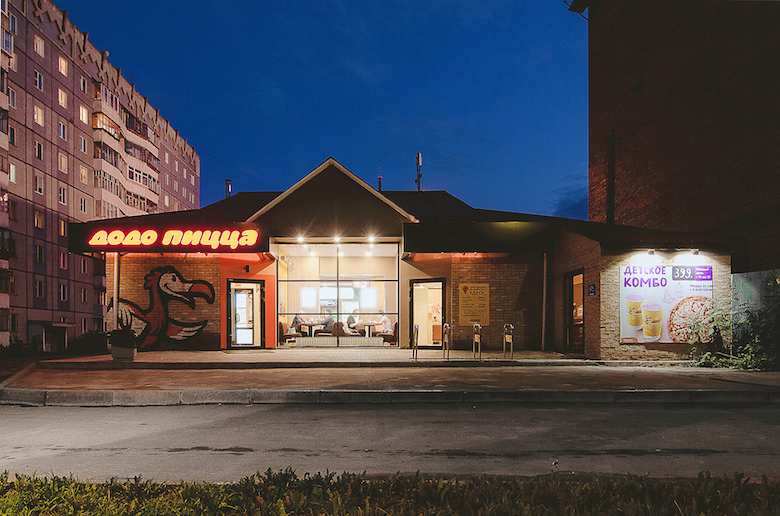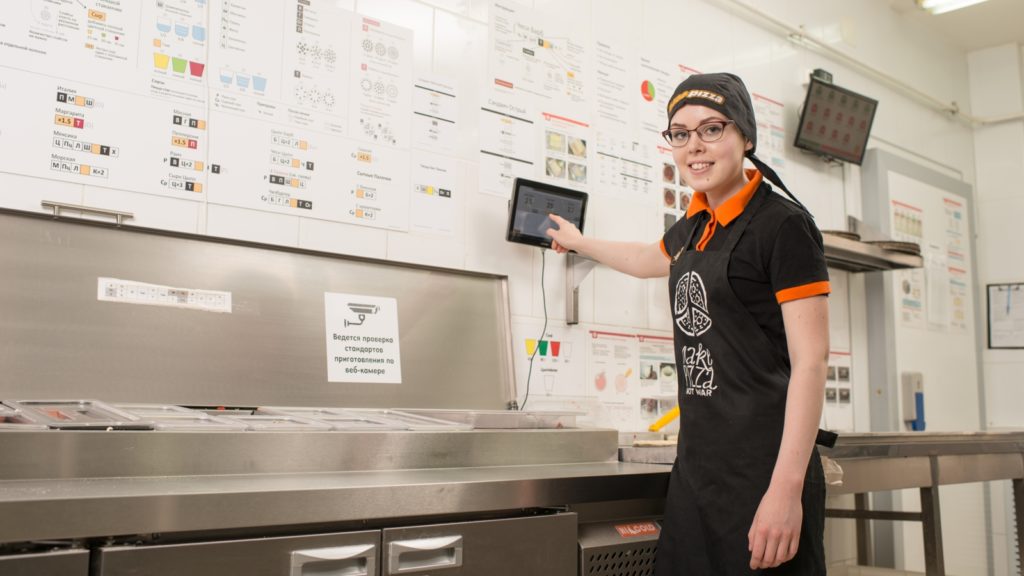
How We Have Gone Bananas
25 August 2015
An entrepreneur told us recently that we’ve gone bananas. When he learned about our plan we’d already put in motion in Oxford, he thought that it was pure insanity. He was sure that we’d never make ends meet and that Dodo Pizza would be out of business in the US in a few months. Well, maybe he’s right. :) Our plan looks as crazy as it does ambitious and promising.
This year we started studying the pizza market in Oxford, Mississippi, where we decided to open our first pizzeria in the US. We had to find an answer to a simple but tricky question: how will we survive here?
The American market is already dominated by the big guys from PJ’s, Domino’s, and other chains. They have thousands of stores. They can spend tons of money on advertising. They get the best prices from the suppliers. They’ve built logistics units all over the country. They own the market. It’s their home.
On the other hand, Dodo Pizza has just shy of 50 stores. We are still a startup. All of our pizzerias are across the ocean—in Eastern Europe. Launching with only one Dodo Pizza in the US, we won’t have the economies of scale. On top of that, our team doesn’t know the specifics of the American market that well.
In spite of this, Dodo Pizza wasn’t coming to the US just to survive. We wouldn’t bother if our goal was just to open a few pizzerias and simply make a profit. That would be too dull.
Too Dull To Fail
Our dream was to change the market and show people a way to significantly improve their quality of life by using smart IT solutions at a traditional “offline” business—an opportunity often overlooked by the smart guys from Silicon Valley.
By wiring our pizzerias with tablets and a cloud-based IT system, we’ve managed to grow our business from scratch in Russia in four years. However, it was clear that here in the US we had to fine-tune our business model to fit the market in the most effective way possible.

When you open a pizzeria, you have to answer a lot of questions. Will you have only a delivery or a restaurant too? Will the menu be typical or unique? What will your prices be? Will you sell alcohol? What kind of message will you send? How will you promote yourself?
But above all, we had to answer one essential question: what would be our big idea in the US that would help us not only succeed in Oxford but build a national American company? What would make us better than others?
The idea of being wired wasn’t enough for that. In a sense, it was too big. Smart IT solutions make you more efficient, that’s true, but you have to decide how to use this efficiency, where to aim it. This aim could be different in different markets. So we started digging.
Same Old Pizza
We decided to cut out the restaurant and focus on delivery only at the first Dodo Pizza in Oxford. We wanted to focus on one thing and make it perfect. At the same time, we saw an interesting opportunity in this market segment in the States.
Fast casual restaurants such as Chipotle or Five Guys have been bringing restaurant quality to the fast food business. Thus, they revolutionized it. But the pizza delivery market is still dominated by the chains launched in the 70s and 80s, and they do the same thing they did ten, even twenty years ago.
It would be a delivery that is still fast but provides you with pizza of restaurant quality made with fresh, tasty ingredients and sold for a reasonable price.
Sound good to be true? We can make it happen thanks to the IT system we’ve been building from the first day Dodo Pizza existed. Now we can track the productivity of any single pizza maker at any of our stores in real time, while our clients can track the status of their pizzas on our website and even see how they are made via webcam. IT makes all this possible.

But the future of this system is even more exciting. With its help, we can carry out a whole fast food revolution—and at last, get rid of a freezer.
The Freezer King
Have you ever wondered what the difference is between a pizza from a nice Italian restaurant and the one you order at your favorite delivery? If the reсipe is almost the same, why does the taste often differ?
It’s simple: the food that goes into your pizza differs. Because at a restaurant, it’s fresh, while at a fast food pizzeria, it’s been frozen.
Any fresh product is too complex. It needs too much attention. If you freeze it, you won’t need to write it off if it gets spoiled, and you won’t need to put a pizza on a stop list because you’re suddenly out of the ingredients.
Every fast food pizzeria is a little factory, and running a factory is always a tough job. The freezer makes this factory more efficient. If you’re efficient, you can make fast deliveries and offer fair prices to your clients.
Almost any fast food company freezes everything it can without sacrificing the taste. Some freeze not only pepperoni but cheese, too (though we don’t go so far even in Russia). We, pizza business owners, always say to ourselves (and to our guests) that we don’t sacrifice taste and quality. Well, maybe only a little. But it’s self-deception, at best.
If you want to deliver good pizza to your customers, then you’ll probably get away with the frozen pepperoni. If you want to make something delicious, you have to use products that were never frozen.
But everything has its price. It’s a commonly-held rule that you can’t be profitable in the pizza delivery business if you don’t freeze.
Well, we’re going to change that.
Too Big To Change
Finally, we thought that we nailed it. We’d offer artisan pizza, made with high-grade, fresh, never-frozen ingredients. That would be our main idea for the US market.
We’d replace the freezer with our IT system. We’d use it to keep the prices reasonable. Our cloud-based system would help us to manage fresh ingredients, lower our spending on salaries, raise efficiency, and stay profitable. We were so sure of it that we decided not to buy a freezer at all.
Now imagine a miracle: we actually manage to implement this concept. People love our pizza, and they value the quality, so they pay more for a better product. We start to grow. Our competitors want to do the same thing to defend their businesses—and they can’t.
They won’t be able to follow us because they’ve invested too much money in the supply chain for frozen ingredients. They are too big to change. They can’t just pull the cord, even if they believed in the ability of IT to solve this kind of problem as much as we do (though, I’m guessing they don’t).
So the idea looked perfect. All we had to do was open the first pizzeria in Oxford and test it.
Our team has done a lot during the previous weeks. We worked hard to find the best location, and we finally rented a nice building downtown (to succeed we had to resolve some issues with the parking lot). We studied the local market. We came up with the menu. We made the layout for our pizzeria.
But I had a feeling that something was missing. The concept we came up with was solid and even bold. We always wanted to love the product we sell and make a difference in the world. And we were going to. But for some reason the idea still looked like it lacked something. It was big. But now it wasn’t big enough.
Then I got it.
Push It Further
I had to admit that our business model didn’t really address the purpose of Dodo Pizza that much: to significantly improve the quality of people’s lives by using smart technology and innovative management.
Would it be a great step forward if we just improved the quality of pizza and raised the price? Was it our destiny to make things a little bit better? Couldn’t we do more than that—instead of enjoying the mediocrity? I proposed to push our idea even further.
It’s no doubt that this sounds much more interesting and compelling. If we fulfill the promise it will blow the market. It will blow my mind because it will mean that the company achieves its main objective—it shows the significance of IT in the traditional business, and it improves the quality of life for everyone. But, well, is it even possible?
That’s a fair question. We went through a lot of debates recently. Some members of our team think that it’s too risky to say that we won’t raise prices while significantly increasing the quality of our products. I argued that we have to burn our bridges and make that promise. We must do it.
Finally, the team agreed. Our new adventure begins in Oxford, MS. There, we will try ourselves and prove that we aren’t just some hopeless dreamers but doers too. We’ve made a huge promise. Now we have to deliver—or at least fail trying.
No Way
When you start a company and open the first store, many people say that you’ll fail.
When you make it successful and open the second store, they say that this time you won’t be that lucky.
When you start to build a national chain, they think it’s a joke.
When you try to raise the money to scale your profitable and growing business via crowdfunding, they say that you’ll get nothing.
When you go from local to global business, they’re laughing at you.
I’ve gotten accustomed to these words. Impossible, fail, no way. Of course, it doesn’t mean that we’re destined to succeed every time. But after all these years in business (almost ten already!), I’ve learned a few insights about entrepreneurship. Here is one of them.
If they say that you’ve gone bananas, there is the ghost of a chance that you’re doing the right thing.
In the next post we’ll describe our business model in detail. When Dodo Pizza in Oxford is open, we’ll publish our financial data, share our profits and losses—and you’ll be able to compare our expectations with the reality. We cover our business in real time.
